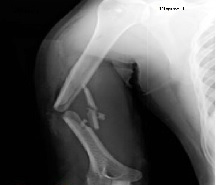Evaluation of results of minimally invasive plate osteosynthesis for humeral shaft fractures. A study involving 40 patients
Abstract
Introduction: Fracture of humeral shaft account for roughly 3% of all fractures. Previously, non-operative treatment has been accepted modality of treatment. Three main operative techniques are in vogue for treating displaced humeral shaft fractures namely intramedullary nailing, conventional plating osteosynthesis (CPO) and minimally invasive plate osteosynthesis (MIPO).
Material and Methods: 40 fractures of humerus shaft were treated with MIPO technique, in a prospective study between December 2015 and September 2017 at our institute. The cases were followed up for a minimum period of 2 years.
Results: The average age was 41 years (23-71 years). Twenty-three (57.5%) were males and 17 (42.5 %) females. Twenty-nine cases (72.5%) had injury in their dominant arm. The mean surgical time was 45.5 minutes and the mean radiation exposure was for 85.3 seconds. The mean follow-up of our cases was 33 months.
Conclusion: MIPO is a better choice for treating humeral shaft fractures than CPO, though there is no significant difference between MIPO and CPO in terms of operative time, fracture union rate, and fracture union time.
Downloads
References
Ekholm R, Adami J, Tidermark J, Tidermark J, Hansson K, Törnkvist H, Ponzer S. Fractures of shaft of humerus. An epidemiological study of 401 fractures. J Bone Joint Surg 2006; 88(11):1469-1473. doi: https://doi.org/10.1302/0301-620X.88B11.17634.
Strohm PC, Reising K, Hammer T, Sudkamp NP, Jaeger M, Schmal H. Humeral shaft fractures- where are we today. Acta Chir Orthop Traumatol Cechoslov. 2011;78(3):185-189.
Cole PA, Wijdicks CA. The operative treatment of humeral diaphyseal fractures. Hand Clin. 2007;23(4):437-448. doi: https://doi.org/10.1016/j.hcl.2007.11.004.
Sarmiento A, Kinman PB, Galvin EG, Schmitt RH, Phillips JG.. Functional bracing of fractures of the shaft of the humerus. J Bone Joint Surg Am. 1977;59(5):596-601.
Biber R, Bail HJ, Geßlein M. Humeral shaft fractures Unfallchirurg. 2018;121(9):747-758. doi: https://doi.org/10.1007/s00113-018-0533-4.
Foster RJ, Dixon GL Jr, Bach AW, Appleyard RW, Green TM. Internal fixation of fractures and nonunion of humeral shaft. Indications and results in a multi-centre study. J Bone Joint Surg. 1985;67(6):857-864.
Jawa A, McCarty P, Doomberg J, Harris M, Ring D. Extrarticular distal third diaphyseal fractures of humerus. A comparison of functional bracing and plate fixation. J Bone Joint Surg. 2006;88(11):2343-2347. doi: https://doi.org/10.2106/JBJS.F.00334.
Zhiquan A, Bingfang Z, Yeming W, Chi Z, Peiyan H. Minimally invasive plating osteosynthesis (MIPO) of middle and distal third humeral shaft fractures. J Orthop Trauma. 2007;21(9):628-633. doi: https://doi.org/10.1097/BOT.0b013e31815928c2.
Ziran BH, Belangero W, Livani B, Pesantez R. Percutaneous plating of the humerus with locked plating: technique and case report. J Traum Acute Care Surg. 2007;63(1):205-210. doi: https://doi.org/10.1097/01.ta.0000231870.11908.3e.
Livani B, Belangero W, Andrade K, Zuiani G, Pratali R. Is MIPO in humeral shaft fractures really safe? Postoperative ultrasonographic evaluation. Int Orthopaed. 2009;33(6):1719-1723. doi: https://doi.org/10.1007/s00264-008-0616-x
Tetsworth K, Hohmann E, Glatt V. Minimally invasive plate osteosynthesis of humeral shaft fractures: current state of the art. JAAOS-J Am Acad Orthopaed Surg. 2018;26(18):652-661. doi: https://doi.org/10.5435/JAAOS-D-17-00238.
Müller ME, Nazarian S, Koch P, Schatzker J. The comprehensive classification of fractures of long bones. Springer Science & Business Media; 2012 Dec 6. doi: https://doi.org/10.1007/978-3-642-61261-9.
Baker SP, o'Neill B, Haddon Jr W, Long WB. The injury severity score: a method for describing patients with multiple injuries and evaluating emergency care. J Trauma Acute Care Surg. 1974;14(3):187-196.
Krettek C, Miclau T, Grün O, Schandelmaier P, Tscherne H. Intraoperative control of axes, rotation and length in femoral and tibial fractures-Technical note. Injury. 1998;29(3):C29-C39. doi: https://doi.org/10.1016/s0020-1383(98)95006-9
Amstutz HC, Sew Hoy AL, Clarke IC. UCLA anatomic total shoulder arthroplasty. Clin Orthop Relat Res. 1981;(155):7-20.
Longo UG, Franceschi F, Loppini M, Maffulli N, Denaro V. Rating systems for evaluation of the elbow. Brit Med Bullet.2008;87(1):131-161. doi: https://doi.org/10.1093/bmb/ldn023.
Petsatodes G, Karataglis D, Papadopoulos P, Christoforides J, Gigis J, Pournaras J. Antegrade interlocking nailing of humeral shaft fractures. J Orthop Sci 2004;9(3):247-252. doi: https://doi.org/10.1007/s00776-004-0780-9.
Santori FS, Santori N. The Exp Nail for the treatment of diaphyseal humeral fractures. J Bone Joint Surg Br 2002;84(3):280.
Bhandari M, Devereaux PJ, McKee MD, Schemitsch EH.. Compression plating versus intramedullary nailing of humeral shaft fractures--a meta-analysis. Acta Orthop. 2006;77(2):279-284. doi: https://doi.org/10.1080/17453670610046037.
Hu X, Xu S, Lu H, Chen B, Zhou X, He X, et al. Minmally invasive plate osteostnthesis v/s conventional fixation techniques for surgically treated humeral shaft fractures: a meta-analysis. J Orthop Surg Res. 2016;11(1):59.
Vande Wall B, Theus C, Link BC, Van Veelen N, Van de Leeuwen RJH, Ganzert C, et al. Absolute or relative stability in plate fixation for simple humeral shaft fractures. Injury. 2019;50(11):1986-1991. doi: https://doi.org/10.1016/j.injury.2019.08.004.
Apivatthakakul T, Arpornchayanon O, Bavornratanavech S. Minimally invasive plate osteosynthesis (MIPO) of the humeral shaft fracture: Is it possible? A cadaveric study and preliminary report. Injury. 2005; 36(4):530-538. doi: https://doi.org/10.1016/j.injury.2004.05.036.
Apivatthakul T, Patiyasikan S, Luevitoonvechkit S. Danger zone for locking screw placement in minimally invasive plate osteosynthesis (MIPO) of humeral shaft fractures: A cadaveric study. Int J Care Injured. 2010;41(2):169-172. doi: https://doi.org/10.1016/j.injury.2009.08.002.
Shetty MS, Kumar MA, Sujay KT, Kini AR, Kanthi KG. Minimally invasive plate osteosynthesis for humerus diaphyseal fractures. Ind J Orthop 2011;45(6);18 521-526. doi: https://doi.org/10.4103/0019-5413.87123.
Fernandez DellOca AA. The principle of helical implants: Unusual ideas worth considering. Injury 2002;33(1):A1-A27. doi: https://doi.org/10.1016/s0020-1383(02)00064-5.
Dabezies EJ, Banta CJ 2 nd , Murphy CP, d'Ambrosia RD. Plate fixation of the humeral shaft for acute fractures, with and without radial nerve injuries. J Orthop Trauma. 1992;6(1):10-13.
Ismail HD, Boedijono DR, Hidayat H, Simbardjo DS. Minimal Invasive Plate Osteosynthesis (MIPO) Technique Using Anterolateral Approach for Treating Closed Proximal Humerus Fracture. Malays Orthop J. 2012;6(1):18-24. doi: https://dx.doi.org/10.5704%2FMOJ.1203.008.
Xue Z, Jiang C, Hu C, Qin H, Ding Q, An Z. Effects of different surgical techniques on mid-distal humeral shaft vascularity: open reduction and internal fixation versus minimally invasive plate osteosynthesis. BMC Musculoskeletal Disord. 2016;17(1):370. doi: https://doi.org/10.1186/s12891-016-1224-3.



 OAI - Open Archives Initiative
OAI - Open Archives Initiative


















 Therapoid
Therapoid

